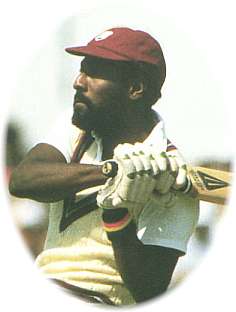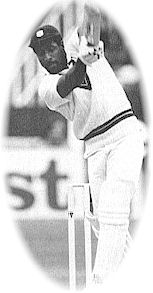Viv Richards: Antigua's pride

NEW DELHI, December 11, 1974. The first day of the second Test between the West Indies and India; opener Murray had gone for a duck and Gordon Greenidge for 31. Vivian Richards, on 12, pushed forward outside the off-stump; the ball went through to the keeper and there was an almighty shout from the whole Indian team. The close fielders could not contain themselves with joy. But the umpire thought otherwise (Richards later said he hadn't got a touch) and the young Antiguan breathed an audible sigh of relief. The defining moment of a great Test career, one which could have plunged his career into a trough of self-doubt, had just passed.
Richards was seen as the brightest of a whole new bunch of players who had been sent to India under a new captain. He had made a total of seven runs in both innings of the first Test, with his bogey being Bhagwat Chandrasekhar. The innings at Delhi was one which could have broken him had he failed to make a sizeable score. As things turned out, it was to be his first Test hundred and very nearly a double hundred at that. He made a glorious 192.
Isaac Vivian Alexander Richards came from an island which, until then, had never had made a mark on West Indies cricket. Not until he and Andy Roberts emerged did the island have any real cricketing heroes of its own. The desire to succeed was thus all the more. He learnt his cricket on the beach and had done enough by the age of 19 to have people saying he was the best prospect the island had ever had. He had learnt one hard lesson at the age of 16 when dissent earned him a two-year ban -- he was out for a duck in the first match of the season against St Kitts and stood his ground at the crease, remonstrating with the umpire. Finally he left the field of play but the crowd took up cudgels for him and invaded the ground. After two hours, things quietened down when Richards was asked to come back and bat again; he made a duck again and followed it up with a duck in the second innings, perhaps the only man to make three noughts in the same game!
The call-up for the national team came after he had got his county cap. After the tour of India, the West Indies went to Australia and took a hammering, the likes of which they would never have to undergo again. Richards was the only player to emerge with an enhanced reputation, having made five hundreds on the tour and ending with an average of over 50. In the midst of this disaster of a tour, Richards showed some of the hallmarks of his batting, taking the battle to the Australian fast bowlers Thomson and Lillee, at times hitting them straight back over their heads. But the pacemen won the battle in the end.

The Indian tour of 1976 saw Richards at his best. He drove, cut and hooked his way to 556 runs in the series, with three big hundreds to boot. The Indians lost the series again; there was unpleasantness in Jamaica though when India, in protest against what captain Bishen Bedi felt was intimidatory bowling, ended its second innings at 97 for 5 with five batsmen recorded as "absent hurt". But Richards's batting did not suffer and he was thus in the perfect mood to go to England for the series which was to create the first of many legends about him.
The England captain was Tony Greig; he had taken over from Mike Denness the previous summer. He was an ebullient sort but he had the habit of making statements which often bordered on the edge of good taste. England had recalled Brian Close, then 45, to the side for the first Test and thus there was some kind of question hanging over the merits of such a team. Greig decided that he had to dispel doubts and in some of his comments to the media mentioned that he and Close would make the West Indies "grovel". This kind of public threat from the South African captain of an English team about a series against the West Indies is probably the closest any cricketer has come to formally declaring a state of war.
Richards is credited with referring to himself in the third person when he heard this extraordinary statement. "Nobody talks to Viv Richards like that," was his response. In his own words: "I felt it was not too brilliant a thing for a South African to say about West Indian players and it made me more determined to do well. The senior players tried to make us put the remark behind us, to forget it. But I can tell you, what Tony had said hung over the particular team meeting and I think it made us all feel that we could not afford to let the folks down."

The very first day of the series, Greig's threat was stuffed down his throat. Richards tore the English attack to shreds, ending on 143 not out. By two on the second day, when he was out, there were 232 runs against his name. The innings was described as a display of "cultured violence." An attack of influenza kept Richards away from the second Test and in the third he got 66 and 38. In the fifth, he exceeded his own display in the first; he was out nine short of a triple hundred. The England captain had been the one who had been made to grovel; 829 runs came off Richards's blade in that series and they were made in a manner that drove home a very sharp lesson to Greig.
But that was only the start and the English attack was only the first to feel what could be likened to withering scorn from his bat. He strode the cricketing fields of every country like a colossus and every team had a chance to feel the destructive power of his heavy willow. It was not merely the runs he scored, it was the way he made them that reduced the oppposition to a helpless set of onlookers who could only wait for the master to leave the stage in order that they could get down to the task of dismissing the humans in the team.
India felt the lash of his whip in 1983 after the West Indies had lost the World Cup final; David Gower's team felt it in 1986 in the Caribbean. Australia took its share of pounding, losing six Tests on either side of five which England lost to the rampaging Windies and Kim Hughes was one of the more noticeable casualties. He reached his peak in 1988-89 and then his last four years in the game were somewhat less dramatic. But of all the cricketers who came through the portals during his time in the international game, none could claim to be king. As well he could.
Many thanks to Sheila Lee for all the great pix of the King.